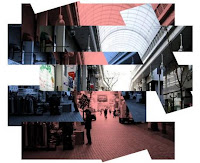Majority
of city's problems can be solved by simply restructuring policies, but physical
infrastructure is more lucrative an option for many.
You
can pump millions of dollars in augmenting and upgrading city infrastructure,
of course you should, but city in its functionality will still remain a mess
and increasingly convoluted unless you pause and think that what has been wrong
with our planning approach, why it is that our planning solutions always seem
to lag far behind the pace of growth, is it revenue constraints? No! Is it land
constraint? No! It is nothing but common sense deficit. It’s simple, if it
doesn’t work go back to the drawing board, put you approach up-side-down or
whatever, something different need to be introduced; at least as an experiment.
Our
conventional planning approach borrowed from industrial age has remained more or
less the same since decades, that is to put it crudely "Planning means
addition", more people - let’s make more housing, more congestion - let’s
make more flyovers, more heat let’s put more air conditioners and so on.
Buildinganother affordable housing is not a problem but it’s also not the solution.
Building another flyover will of course ease the traffic for sometime but it is
also not the solution which cities are looking for. The single largest criteria
of a livable city can be effortlessness of any city, but effort seems to be the
mandate of our city life.
Have we ever considered why such sheer number of people are heading to metropolis in the first place apart from recreational purposes, it’s not because metropolis provide better employment opportunities, it’s because we simply fail to provide livelihood opportunity in small towns and villages. Can we suggest something to calm down this vary pace of regional population flux, instead of simply focusing on making another housing colony here in every metropolis, can we propose something which will help people earn their livelihood in the place of their choice not only in the place where they often come to struggle and survive.
Have we ever considered why such sheer number of people are heading to metropolis in the first place apart from recreational purposes, it’s not because metropolis provide better employment opportunities, it’s because we simply fail to provide livelihood opportunity in small towns and villages. Can we suggest something to calm down this vary pace of regional population flux, instead of simply focusing on making another housing colony here in every metropolis, can we propose something which will help people earn their livelihood in the place of their choice not only in the place where they often come to struggle and survive.
Have
we ever considered before making another flyover that why so many people and
car out there on the roads in the first place, is it really necessary in this
so called wired era for every single individual to commute to work to
accomplish a job, is it that being physically present at a specified location
every work weekday is of such monumental importance in a time of century were
everyone claim to be virtually connected to everyone and having access to the
resources of whole world on their finger tip. Considering this can we suggest
something to reduce the very need or frequency of people to come to streets,
people who commute to work 5-6 days a week or 24 to 40 hour a week.
Why people have to waste a substantial portion of their productive lifetime commuting on city roads or tracks, commuting long hours to work mostly doing nothing, may be listening to music or playing video game on their tab, why to commute to work unless they work in a factory like production environment.
Why people have to waste a substantial portion of their productive lifetime commuting on city roads or tracks, commuting long hours to work mostly doing nothing, may be listening to music or playing video game on their tab, why to commute to work unless they work in a factory like production environment.
You
see we are so caught up in the debate of public transport vs. private transit
vs. walkability that no one is willing to ask this fundamental question why
does every one of you have to commute almost every day for the purpose of work
choking almost every street of city, why have we created such system or
business environment or society in general. We simply can’t seem to think of
any other possibility than expanding infrastructure trying to meet the pressure
of self imposed need of commuting for work.
Whether
travelling through private or public transport or walking to work, it’s still a
waste of precious time, energy and resources. Can you even imaging the lost
opportunity cost of millions of people spending several hours commuting to
work-home-work almost every day of their productive like. After decades of
industrialization is it still so important even today for 200 employees of a
random organization to agglomerate everyday at a specific place called office
at a specific time to accomplish some work, majority of which can be done from
anywhere in the world, majority of which on majority of days does not
fundamentally demand physical presence of worker or employee in office. Can’t
we instead of simply expanding the city and transport network think of reducing
the number and frequency of trip to work? Can’t we think of increasing the
share of recreational trip and reducing the work trip instead of aggressively
focusing on increasing the share of public transport?
This
conventional additive approach of planning is a vicious cycle of inefficiency
perceived as virtuous cycle and promoted relentlessly without delving deep into
the roots of problem and without pausing and questioning the inertia of planning
process. Instead of this additive approach, a supplementary approach of
planning is needed for fostering and supporting equitable growth across the region,
and at the same time conventional planning wisdom which is dear to many, needto be questioned!


